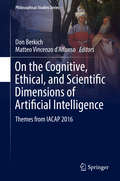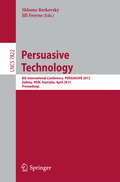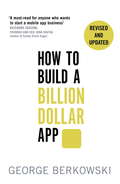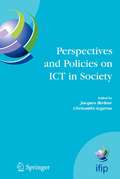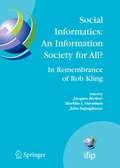- Table View
- List View
Sacred Ecology
by Fikret BerkesSacred Ecology examines bodies of knowledge held by indigenous and other rural peoples around the world, and asks how we can learn from this knowledge and ways of knowing. Berkes explores the importance of local and indigenous knowledge as a complement to scientific ecology, and its cultural and political significance for indigenous groups themselves. With updates of relevant links for further learning and over 180 new references, the fourth edition gives increased voice to indigenous authors, and reflects the remarkable increase in published local observations of climate change.
Environmental Justice and Farm Labor (Earthscan Food and Agriculture)
by Rebecca E. BerkeyUtilizing a model derived from literature on environmental justice overlaid with multiple scales of agriculture, Environmental Justice and Farm Labor provides key insights about laborers in agriculture in the United States. It addresses three main topics: (1) justice-related issues facing farmers and laborers on farms; (2) how history and policy have impacted them; and (3) the opportunities and leverage points for change in improving justice outcomes. It explores who labors in US agriculture and the justice-related issues facing these workers, including occupational injury and illness, lack of access to healthcare, substandard housing, hunger, low wages, issues pertaining to immigration, and the inability to organize. In addition, it assesses the impacts of labor safety, immigration and international policy, and in particular the effects of organic and fair trade certification. Two detailed case studies, one based on conventional agriculture in Florida and the other on organic agriculture in the Northeast, highlight the interrelated but unique challenges facing those who labor in the different sectors of this complex agricultural system. Finally, it touches on justice claims and the role of grassroots activism in improving justice outcomes by highlighting organizations operating at multiple scales to contribute to the livelihood of farmers and laborers in the different areas of agriculture.
Environmental Justice and Farm Labor (Earthscan Food and Agriculture)
by Rebecca E. BerkeyUtilizing a model derived from literature on environmental justice overlaid with multiple scales of agriculture, Environmental Justice and Farm Labor provides key insights about laborers in agriculture in the United States. It addresses three main topics: (1) justice-related issues facing farmers and laborers on farms; (2) how history and policy have impacted them; and (3) the opportunities and leverage points for change in improving justice outcomes. It explores who labors in US agriculture and the justice-related issues facing these workers, including occupational injury and illness, lack of access to healthcare, substandard housing, hunger, low wages, issues pertaining to immigration, and the inability to organize. In addition, it assesses the impacts of labor safety, immigration and international policy, and in particular the effects of organic and fair trade certification. Two detailed case studies, one based on conventional agriculture in Florida and the other on organic agriculture in the Northeast, highlight the interrelated but unique challenges facing those who labor in the different sectors of this complex agricultural system. Finally, it touches on justice claims and the role of grassroots activism in improving justice outcomes by highlighting organizations operating at multiple scales to contribute to the livelihood of farmers and laborers in the different areas of agriculture.
On the Cognitive, Ethical, and Scientific Dimensions of Artificial Intelligence: Themes from IACAP 2016 (Philosophical Studies Series #134)
by Don Berkich Matteo Vincenzo D'AlfonsoThis edited volume explores the intersection between philosophy and computing. It features work presented at the 2016 annual meeting of the International Association for Computing and Philosophy. The 23 contributions to this volume neatly represent a cross section of 40 papers, four keynote addresses, and eight symposia as they cut across six distinct research agendas. The volume begins with foundational studies in computation and information, epistemology and philosophy of science, and logic. The contributions next examine research into computational aspects of cognition and philosophy of mind. This leads to a look at moral dimensions of man-machine interaction as well as issues of trust, privacy, and justice. This multi-disciplinary or, better yet, a-disciplinary investigation reveals the fruitfulness of erasing distinctions among and boundaries between established academic disciplines. This should come as no surprise. The computational turn itself is a-disciplinary and no former discipline, whether scientific, artistic, or humanistic, has remained unchanged. Rigorous reflection on the nature of these changes opens the door to inquiry into the nature of the world, what constitutes our knowledge of it, and our understanding of our place in it. These investigations are only just beginning. The contributions to this volume make this clear: many encourage further research and end with open questions.
Religious Pluralism and the City: Inquiries into Postsecular Urbanism (Bloomsbury Studies in Religion, Space and Place)
by Helmuth Berking Silke Steets Jochen SchwenkReligious Pluralism and the City challenges the notion that the city is a secular place, and calls for an analysis of how religion and the city are intertwined. It is the first book to analyze the explanatory value of a number of typologies already in use around this topic – from "holy city" to "secular city", from "fundamentalist" to "postsecular city". By intertwining the city and religion, urban theory and theories of religion, this is the first book to provide an international and interdisciplinary analysis of post-secular urbanism.The book argues that, given the rise of religiously inspired violence and the increasing significance of charismatic Christianity, Islam and other spiritual traditions, the master narrative that modern societies are secular societies has lost its empirical plausibility. Instead, we are seeing the pluralization of religion, the co-existence of different religious worldviews, and the simultaneity of secular and religious institutions that shape everyday life. These particular constellations of "religious pluralism" are, above all, played out in cities. Including contributions from Peter L. Berger and Nezar Alsayyad, this book conceptually and empirically revokes the dissolution between city and religion to unveil its intimate relationship, and offers an alternative view on the quotidian state of the global urban condition.
Religious Pluralism and the City: Inquiries into Postsecular Urbanism (Bloomsbury Studies in Religion, Space and Place)
by Helmuth Berking Silke Steets Jochen SchwenkReligious Pluralism and the City challenges the notion that the city is a secular place, and calls for an analysis of how religion and the city are intertwined. It is the first book to analyze the explanatory value of a number of typologies already in use around this topic – from "holy city" to "secular city", from "fundamentalist" to "postsecular city". By intertwining the city and religion, urban theory and theories of religion, this is the first book to provide an international and interdisciplinary analysis of post-secular urbanism.The book argues that, given the rise of religiously inspired violence and the increasing significance of charismatic Christianity, Islam and other spiritual traditions, the master narrative that modern societies are secular societies has lost its empirical plausibility. Instead, we are seeing the pluralization of religion, the co-existence of different religious worldviews, and the simultaneity of secular and religious institutions that shape everyday life. These particular constellations of "religious pluralism" are, above all, played out in cities. Including contributions from Peter L. Berger and Nezar Alsayyad, this book conceptually and empirically revokes the dissolution between city and religion to unveil its intimate relationship, and offers an alternative view on the quotidian state of the global urban condition.
Sociology of Giving (PDF)
by Professor Helmuth BerkingThis book decodes the ambivalence of gift-giving. It examines its socio-ethical and integrative potential. Following a short recollection of contemporary gift-giving, its motives, occasions and its rules, the reader is invited to travel back in time and space examining 'sacrifice', 'food-sharing', and 'gift giving' as those basic institutions upon which symbolic orders of 'traditional' society rely. The historical invention of hospitality is considered and paves the way to an analysis of the anthropology of giving. Berking goes on to explore the transition from traditional society to the market, self interest form. He questions the view that our societies are dominated by individualism and explores the contemporary interplay between self interest and the common good.
Intercultural Communication for the Global Business Professional
by Mara K. Berkland Amy Grim BuxbaumThis text integrates business and communication concepts to immerse students in the global communication experiences of business professionals. The authors argue that the essentials of intercultural communication, such as nonverbal communication, conflict, meeting management, interviewing, and negotiations are most useful to burgeoning professionals when they are woven into discussions about economic systems, market forces, production processes, finance structures, and human resources priorities. Each chapter begins with an explanation of theories and key terms appropriate for introductory-level students in both business and communication, then supplements that discussion with examples that demonstrate the concepts at work. The cases chosen represent different market systems in both dominant and emerging economies, explaining the cultures of competitive markets with a global perspective rather than focusing on the United States. This book is ideal as a text for courses in international business or professional intercultural communication, or as a supplement for more general business and communication courses.
Education Policy, Theories, and Trends in the 21st Century: International and Israeli Perspectives (Policy Implications of Research in Education #12)
by Izhak BerkovichThis book provides a highly accessible overview of public education policy. It organizes knowledge about 21st century education policy around two main topics: the policy process, and the discourse on public education policy. This unique organization provides a novel lens for better understanding the dynamics and contents of current education policy making. The work also offers a broad overview of theories of public policy, economics, demography, sociology, history, and psychology. Each chapter includes a discussion of data derived from the international and Israeli contexts. The book provides a series of valuable insights relevant to researchers, practitioners, and policymakers interested in understanding the multifaceted aspects that shape contemporary education policy.
Persuasive Technology: 8th International Conference, PERSUASIVE 2013, Sydney, NSW, Australia, April 3-5, 2013. Proceedings (Lecture Notes in Computer Science #7822)
by Shlomo Berkovsky Jill FreyneThis book constitutes the refereed proceedings of the 8th International Conference on Persuasive Technology, PERSUASIVE 2013, held in Sydney, NSW, Australia, in April 2013. The 16 revised full papers and 12 revised short papers presented were carefully reviewed and selected from 47 submissions. The papers address not only typical persuasive domains like health and environment, but also cover emerging research topics, such as data safety and evaluation of persuasive technologies.
Making Social Welfare Policy in America: Three Case Studies since 1950
by Edward D. BerkowitzAmerican social welfare policy has produced a health system with skyrocketing costs, a disability insurance program that consigns many otherwise productive people to lives of inactivity, and a welfare program that attracts wide criticism. Making Social Welfare Policy in America explains how this happened by examining the historical development of three key programs—Social Security Disability Insurance, Medicare, and Temporary Aid to Needy Families. Edward D. Berkowitz traces the developments that led to each program’s creation. Policy makers often find it difficult to dislodge a program’s administrative structure, even as political, economic, and cultural circumstances change. Faced with this situation, they therefore solve contemporary problems with outdated programs and must improvise politically acceptable solutions. The results vary according to the political popularity of the program and the changes in the conventional wisdom. Some programs, such as Social Security Disability Insurance, remain in place over time. Policy makers have added new parts to Medicare to reflect modern developments. Congress has abolished Aid to Families of Dependent Children and replaced with a new program intended to encourage work among adult welfare recipients raising young children. Written in an accessible style and using a minimum of academic jargon, this book illuminates how three of our most important social welfare programs have come into existence and how they have fared over time.
Making Social Welfare Policy in America: Three Case Studies since 1950
by Edward D. BerkowitzAmerican social welfare policy has produced a health system with skyrocketing costs, a disability insurance program that consigns many otherwise productive people to lives of inactivity, and a welfare program that attracts wide criticism. Making Social Welfare Policy in America explains how this happened by examining the historical development of three key programs—Social Security Disability Insurance, Medicare, and Temporary Aid to Needy Families. Edward D. Berkowitz traces the developments that led to each program’s creation. Policy makers often find it difficult to dislodge a program’s administrative structure, even as political, economic, and cultural circumstances change. Faced with this situation, they therefore solve contemporary problems with outdated programs and must improvise politically acceptable solutions. The results vary according to the political popularity of the program and the changes in the conventional wisdom. Some programs, such as Social Security Disability Insurance, remain in place over time. Policy makers have added new parts to Medicare to reflect modern developments. Congress has abolished Aid to Families of Dependent Children and replaced with a new program intended to encourage work among adult welfare recipients raising young children. Written in an accessible style and using a minimum of academic jargon, this book illuminates how three of our most important social welfare programs have come into existence and how they have fared over time.
Making Social Welfare Policy in America: Three Case Studies since 1950
by Edward D. BerkowitzAmerican social welfare policy has produced a health system with skyrocketing costs, a disability insurance program that consigns many otherwise productive people to lives of inactivity, and a welfare program that attracts wide criticism. Making Social Welfare Policy in America explains how this happened by examining the historical development of three key programs—Social Security Disability Insurance, Medicare, and Temporary Aid to Needy Families. Edward D. Berkowitz traces the developments that led to each program’s creation. Policy makers often find it difficult to dislodge a program’s administrative structure, even as political, economic, and cultural circumstances change. Faced with this situation, they therefore solve contemporary problems with outdated programs and must improvise politically acceptable solutions. The results vary according to the political popularity of the program and the changes in the conventional wisdom. Some programs, such as Social Security Disability Insurance, remain in place over time. Policy makers have added new parts to Medicare to reflect modern developments. Congress has abolished Aid to Families of Dependent Children and replaced with a new program intended to encourage work among adult welfare recipients raising young children. Written in an accessible style and using a minimum of academic jargon, this book illuminates how three of our most important social welfare programs have come into existence and how they have fared over time.
Making Social Welfare Policy in America: Three Case Studies since 1950
by Edward D. BerkowitzAmerican social welfare policy has produced a health system with skyrocketing costs, a disability insurance program that consigns many otherwise productive people to lives of inactivity, and a welfare program that attracts wide criticism. Making Social Welfare Policy in America explains how this happened by examining the historical development of three key programs—Social Security Disability Insurance, Medicare, and Temporary Aid to Needy Families. Edward D. Berkowitz traces the developments that led to each program’s creation. Policy makers often find it difficult to dislodge a program’s administrative structure, even as political, economic, and cultural circumstances change. Faced with this situation, they therefore solve contemporary problems with outdated programs and must improvise politically acceptable solutions. The results vary according to the political popularity of the program and the changes in the conventional wisdom. Some programs, such as Social Security Disability Insurance, remain in place over time. Policy makers have added new parts to Medicare to reflect modern developments. Congress has abolished Aid to Families of Dependent Children and replaced with a new program intended to encourage work among adult welfare recipients raising young children. Written in an accessible style and using a minimum of academic jargon, this book illuminates how three of our most important social welfare programs have come into existence and how they have fared over time.
Making Social Welfare Policy in America: Three Case Studies since 1950
by Edward D. BerkowitzAmerican social welfare policy has produced a health system with skyrocketing costs, a disability insurance program that consigns many otherwise productive people to lives of inactivity, and a welfare program that attracts wide criticism. Making Social Welfare Policy in America explains how this happened by examining the historical development of three key programs—Social Security Disability Insurance, Medicare, and Temporary Aid to Needy Families. Edward D. Berkowitz traces the developments that led to each program’s creation. Policy makers often find it difficult to dislodge a program’s administrative structure, even as political, economic, and cultural circumstances change. Faced with this situation, they therefore solve contemporary problems with outdated programs and must improvise politically acceptable solutions. The results vary according to the political popularity of the program and the changes in the conventional wisdom. Some programs, such as Social Security Disability Insurance, remain in place over time. Policy makers have added new parts to Medicare to reflect modern developments. Congress has abolished Aid to Families of Dependent Children and replaced with a new program intended to encourage work among adult welfare recipients raising young children. Written in an accessible style and using a minimum of academic jargon, this book illuminates how three of our most important social welfare programs have come into existence and how they have fared over time.
Making Social Welfare Policy in America: Three Case Studies since 1950
by Edward D. BerkowitzAmerican social welfare policy has produced a health system with skyrocketing costs, a disability insurance program that consigns many otherwise productive people to lives of inactivity, and a welfare program that attracts wide criticism. Making Social Welfare Policy in America explains how this happened by examining the historical development of three key programs—Social Security Disability Insurance, Medicare, and Temporary Aid to Needy Families. Edward D. Berkowitz traces the developments that led to each program’s creation. Policy makers often find it difficult to dislodge a program’s administrative structure, even as political, economic, and cultural circumstances change. Faced with this situation, they therefore solve contemporary problems with outdated programs and must improvise politically acceptable solutions. The results vary according to the political popularity of the program and the changes in the conventional wisdom. Some programs, such as Social Security Disability Insurance, remain in place over time. Policy makers have added new parts to Medicare to reflect modern developments. Congress has abolished Aid to Families of Dependent Children and replaced with a new program intended to encourage work among adult welfare recipients raising young children. Written in an accessible style and using a minimum of academic jargon, this book illuminates how three of our most important social welfare programs have come into existence and how they have fared over time.
The Other Welfare: Supplemental Security Income and U.S. Social Policy
by Edward D. Berkowitz Larry DeWittThe Other Welfare offers the first comprehensive history of Supplemental Security Income (SSI), from its origins as part of President Nixon’s daring social reform efforts to its pivotal role in the politics of the Clinton administration. Enacted into law in 1972, Supplemental Security Income (SSI) marked the culmination of liberal social and economic policies that began during the New Deal. The new program provided cash benefits to needy elderly, blind, and disabled individuals. Because of the complex character of SSI—marking both the high tide of the Great Society and the beginning of the retrenchment of the welfare state—it provides the perfect subject for assessing the development of the American state in the late twentieth century. SSI was launched with the hope of freeing welfare programs from social and political stigma; it instead became a source of controversy almost from its very start. Intended as a program that paid uniform benefits across the nation, it ended up replicating many of the state-by-state differences that characterized the American welfare state. Begun as a program intended to provide income for the elderly, SSI evolved into a program that served people with disabilities, becoming a primary source of financial aid for the deinstitutionalized mentally ill and a principal support for children with disabilities.Written by a leading historian of America’s welfare state and the former chief historian of the Social Security Administration, The Other Welfare illuminates the course of modern social policy. Using documents previously unavailable to researchers, the authors delve into SSI’s transformation from the idealistic intentions of its founders to the realities of its performance in America’s highly splintered political system. In telling this important and overlooked history, this book alters the conventional wisdom about the development of American social welfare policy.
Moral Education: Theory and Application
by M. W. Berkowitz F. OserFirst published in 1985. Routledge is an imprint of Taylor & Francis, an informa company.
How to Build a Billion Dollar App: Discover the secrets of the most successful entrepreneurs of our time
by George BerkowskiTHE ULTIMATE GUIDE TO BUILDING AN APP-BASED BUSINESS 'A must read for anyone who wants to start a mobile app business' Riccardo Zacconi, founder and CEO King Digital (maker of Candy Crush Saga) 'A fascinating deep dive into the world of billion-dollar apps. Essential reading for anyone trying to build the next must-have app' Michael Acton Smith, Founder and CEO, Mind Candy Apps have changed the way we communicate, shop, play, interact and travel and their phenomenal popularity has presented possibly the biggest business opportunity in history.In How to Build a Billion Dollar App, serial tech entrepreneur George Berkowski gives you exclusive access to the secrets behind the success of the select group of apps that have achieved billion-dollar success.Berkowski draws exclusively on the inside stories of the billion-dollar app club members, including Instagram, Whatsapp, Snapchat, Candy Crush and Uber to provide all the information you need to create your own spectacularly successful mobile business. He guides you through each step, from an idea scribbled on the back of an envelope, through to finding a cofounder, building a team, attracting (and keeping) millions of users, all the way through to juggling the pressures of being CEO of a billion-dollar company (and still staying ahead of the competition).If you've ever dreamed of quitting your nine to five job to launch your own company, you're a gifted developer, seasoned entrepreneur or just intrigued by mobile technology, How to Build a Billion Dollar App will show you what it really takes to create your own billion-dollar, mobile business.
Perspectives and Policies on ICT in Society: An IFIP TC9 (Computers and Society) Handbook (IFIP Advances in Information and Communication Technology #179)
by Jacques Berleur Chrisanthi AvgerouGovernments, the media, the information technology industry and scientists publicly argue that information and communication technologies (ICT) will bring about an inevitable transition from "industrial" to "information" or "knowledge-based" economies and societies. It is assumed that all aspects of our economic and social lives, in both the public and private spheres, will be radically different from what they are today. The World Summit on the Information Society (Geneva 2003 - Tunis 2005) shows the importance of a worldwide reflection on those topics. Perspectives and Policies on ICT in Society explores the ICT policies of different nations and regions such as Africa, China, Europe, and India. The authors assess the arguments surrounding the impending new age, as well as some of the more sensitive issues of its developments. This progress will signal an expansion of ICT in many domains - the so-called ubiquity - such as in the workplace, the home, government, and education and it will affect privacy and professional ethics. The expansion will also encompass all parts of the earth, particularly developing countries. Such growth must take place in the context of historical dimensions and should underscore the accountability of professionals in the field. The intent of this book is to address these issues and to serve as a handbook of IFIP's TC9 "Computers and Society" committee. Thirty authors from twelve countries consider the ICT policies with their associated perspectives and they explore what may be the information age and the digital society of tomorrow. The book provides reflection on today's complex society and addresses the uncertain developments rising from an increasingly global and technologically connected world. Jacques Berleur is at the University of Namur, Belgium, and Chrisanthi Avgerou at the London School of Economics, United Kingdom.
Social Informatics: Proceedings of the Seventh International Conference 'Human Choice and Computers' (HCC7), IFIP TC 9, Maribor, Slovenia, September 21-23, 2006 (IFIP Advances in Information and Communication Technology #223)
by Jacques Berleur Markku I. Nurminen John ImpagliazzoThe principal message of the ‘Human Choice and Computers’ (HCC) tradition and its associated conferences over the years is that there are choices and alternatives. In this volume, Social Informatics takes two directions. The first supports readers in interpreting of the meaning of Social Informatics. The second, more extensive part develops an overview of various applications of Social Informatics. Researchers inspired by Social Informatics touch many areas of human and social life.
Bewertungskulturen (Soziologie des Wertens und Bewertens)
by Oliver Berli Stefan Nicolae Hilmar SchäferBewertungsphänomene wie Rankings und Ratings sind in Gegenwartsgesellschaften weit verbreitet. Sie werfen gleichermaßen theoretische wie politische Fragen auf und fordern die soziologische Analyse heraus. Der Band versammelt Studien zu Bewertungsphänomen in unterschiedlichen sozialen Sphären (u.a. Alltag, digitalen Medien, Kultur, Sport und Wissenschaft) und bringt sie miteinander ins Gespräch. Zugleich wirbt er für eine konsequent vergleichende Perspektive, die unterschiedliche Bewertungskulturen in Gegenwartsgesellschaften umfassend nachzeichnet.
Who You Think I Am?: Masken in der Pop-Musik (Essays zur Gegenwartsästhetik)
by Sebastian BerlichPop-Stars sind uns nahe. In ihren Songs, ihren Bildern, ihren Stories auf Instagram. Gesucht ist ein authentischer Eindruck. Echte Gefühle auf echten Gesichtern. Aber was passiert, wenn sie ihr Gesicht mit einer Maske verdecken? Und zwar dauerhaft, als zweites Gesicht. Das Phänomen findet sich im Mainstream wie im Underground. Die Maske bricht dabei nicht mit dem Ideal von Authentizität. Vielmehr verweist sie je nach Inszenierung auf verschiedenste Diskurse, kann cool oder grotesk wirken, zum Logo werden oder Anonymität herstellen. Der Essay zeigt an zwei Beispielfällen (Sido, Slipknot), wie die Maske die Persona von Pop-Stars konstruiert – und enthüllt damit Strukturen der Pop-Musik.
Who You Think I Am?: Masks in Pop Music
by Sebastian BerlichPop stars are close to us. In their songs, their pictures, their stories on Instagram. What we are looking for is an authentic impression. Real feelings on real faces. But what happens when they cover their face with a mask? Permanently, as a second face. The phenomenon can be found in the mainstream as well as in the underground. The mask does not break with the ideal of authenticity. Rather, depending on how it is staged, it refers to the most diverse discourses, can appear cool or grotesque, become a logo or create anonymity. The essay uses mainly two examples (Sido, Slipknot) to show how the mask constructs the persona of pop stars - and thus reveals structures of pop music.



